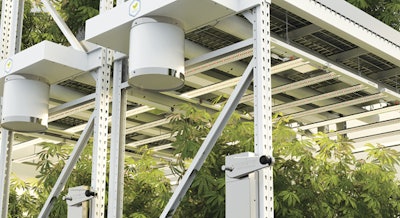
As competition in the cannabis industry continues to increase, more growers look to maximize their footprint and efficiency with equipment such as vertical racking and advanced benching options.
The Cannabis Business Times 2024 “State of the Cannabis Lighting Market” report revealed that 30% of indoor and greenhouse growers cultivating under supplemental lighting already use at least two tiers of racks in flower. For vegetation, excluding propagation, that number rose to 42%. Many more growers reported plans to go vertical within the following year.
Chris Mayer founded Innovative Growers Equipment (IGE), a Hydrofarm brand and a leading producer of premium “Made in the USA” racking and benching for the cannabis industry, in 2016. Mayer says an evolution is underway as growers move from standard benches to track benches or multi-tier racks.
“More growers care more about efficiency and yield today than they ever have, just because of the challenging market out there,” Mayer says. “Instead of building two 1,000-square-foot rooms to get 2,000 square feet of canopy, why not build one 1,000-square-foot room that has 2,000 square feet of canopy in it? It’s more cost-effective.”
While trends indicate growers understand the logic, buying racking and benching represents a significant expenditure for cultivators already pinched by price compression and rising input costs. But by understanding crucial differences in racking and benching, you can make quality decisions and purchases for your grow.
Why Small Details Matter for Longevity and Safety
While the quality of racking and benching products is an obvious consideration, Mayer points out that “quality” is a very broad term. Zeroing in on equipment details can bring superior quality into focus.
One simple example is the wheel on a rack, which can vary significantly between racking providers. It can also have implications for employee and plant safety, and equipment longevity.
One harvest typically pays for the whole system.” — Chris Mayer
As Mayer points out, a lot rests on your racks’ wheels: “Employee safety is paramount when working on vertical racking systems. Compromising on quality isn’t an option. Likewise, plants are very expensive, you want to ensure they're stable and well taken care of.”
Some racking vendors use zinc-coated steel wheels, which may resist rust but aren’t rustproof, Mayer says. After a year or two in a production setting, he says those wheels will start to wear down and cause problems, in sharp contrast to rustproof stainless steel.
Medical-grade solid stainless-steel wheels, like the 4.5-inch wheels on IGE archive racks, allow no rust, he says. “What that means is it has longevity and they’re never going to wear out.”
Thicker Metal = Stronger, Safer, Longer-Lasting Racks
Mayer explains that metal thickness is another primary consideration when comparing the overall quality of racking and benching equipment. Ask questions and look closely at what you may buy.
“It’s important to look at diameters of hardware. For example, bolts and nuts, the wheels—the actual thickness of all the metal,” Mayer says. “If your wall thickness of a tube is only an eighth of an inch versus a quarter inch, you won't actually know that without seeing the inside.”
While two pieces of equipment may look the same, differences in metal thickness impact stability and longevity of the structural components. Mayer says thinner metal will start to bow over time and cause binding problems with your racking and benching products.
On a closely related note, Mayer advises growers to pay attention to the weight capacity of the racking and benching products. Not all products on the market can get the job done. “Our racking itself is industrial-capacity racking, so it has the weight capacity to hold way more than a plant,” Mayer adds.
The same quality should extend to peripherals, such as plastic trays. IGE uses Staal and Plast Ebb and Flow trays in all of its rack systems. “They’re the industry leader in plastic trays, and we have all those in stock for immediate delivery,” Mayer adds.
Precision ‘Made in the USA’ Manufacturing
Joints and corners on your racks or benching can be primary indicators of the manufacturing quality and precision cuts and welds that did or didn’t go into your equipment. Mayer says that approaches to production are major differentiators between racking and benching vendors.
He explains that many racking suppliers buy precut, pre-punched or pre-drilled products, then assemble the final products in a warehouse. “In reality, it’s more of an assembly house or an aggregator,” he says.
In contrast, virtually every part of an IGE product is made from raw material in the company’s Sycamore, Ill., warehouse from steel bought in bundle loads directly from a steel mill and cut on site. The products meet the stringent requirements needed to carry the “Made in the USA” label.
“Our factory is over 300,000 square feet of metal factory, all precision equipment, so everything you get here is made from raw material,” Mayer says. Circling back to IGE rack wheels, he says they start as a 12-foot, solid stainless-steel bar that undergoes an automated process that cuts the steel within 1/10,000th of an inch accuracy.
The work of highly trained, highly skilled human welders, high-precision robotic welders, and high-precision, high-speed metal lasers stands out when you compare joints and corners on benches and racks, he says. You won’t see sharp corners on quality products, Mayer adds. Look for features like rounded corners made from custom aluminum extrusion instead.
ROI on Your Quality Racking
With ROI at the forefront for many would-be racking buyers, Mayer says to start by comparing products of similar quality, then look for competitive pricing on higher quality products. Pricing on racking and benching projects can vary significantly, especially when orders are customized to individual grows.
“We like to tell customers honestly, if you can dream it, we can make it. Anything you want to make in metal, plastic or aluminum or stainless steel, we can make it happen,” he says.
Although IGE uses a module-style design system, the array of parts go together in different shapes or form factors, so no order is the same. Economies of scale set in so that larger orders tend to come down to less money per square foot, but Mayer explains that’s due to scale of shipping, not cheaper product.
In general, ROI estimates are relatively simple. “In a grow room, if you're able to get 20% more canopy in that grow room by using these racks versus growing on a stationary table or on the floor or on some other metric, one harvest typically pays for the whole system,” Mayer says.
“Obviously, that's dependent on the state and the price per pound. But we can do a full ROI on a specific project, and we're happy to do that for any client. We just need to know their exact specs.”
Support Before and After the Sale
Mayer advises racking and benching shoppers not to overlook the importance of availability and support before and after you buy. The cannabis industry is rife with stories of growers deserted by vendors who went out of business, “disappeared” after the sale, or moved on to new designs.
“We've been providing these products now for going on almost 10 years, specifically to the cannabis sector, and a lot of our designs have stayed the same,” Mayer says. “As we launch new products, we always keep in mind our current and previous customers to figure out how this new product can integrate with their products they bought before.”
Whatever your goals and plans for racking and benching, working with a quality provider that offers services from engineering and design to full installation can be key to seeing your dreams for your grow fulfilled.
“We like to get in from day one to help design the facility before it’s built, to help point out mistakes before they happen, free of charge. Our motto is always, the more successful the grower is, the more successful we will be,” Mayer says.
More from our latest newsletter:


